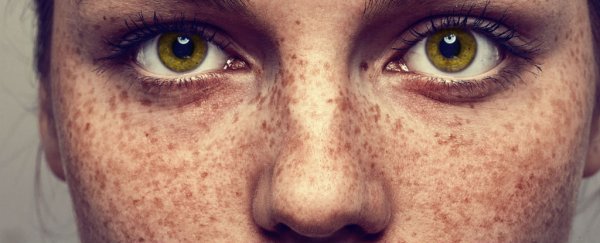
If you have a lot of freckles, you're probably used to people commenting on them, whether it's schoolyard teasing or compliments on how pretty they are, and you've no doubt suffered the indignity of watching Lindsay Lohan distance herself from her own, perfectly acceptable freckles for some reason.
While having lots of freckles is relatively rare amongst the global population, many people have a light sprinkling around the bridge of the nose and cheeks. And yet, for something so common, we still don't actually know why some people get freckles, and why some people get way more freckles than others.
As the latest episode of SciShow explains, freckles are small dots that contain high amounts of melanin - the protein that's responsible for pigmenting our skin, eyes, and hair. Having melanin is great - it's produced by specialised cells called melanocytes in response to sunlight, which darkens your skin and creates a protective layer that partially blocks the effects of harmful UV rays.
In people without any freckles, melanin is produced evenly across the skin. But in some people, melanin is produced in little clumps, and these get darker when exposed to sunlight - hello, freckles! - and lighter when there's less sunlight, like during the winter months.
That's why you'll never see a baby born with freckles - they might be there, but you need sun exposure to make them visible.
Interestingly, while freckles might seem pretty similar to other pigmentation conditions, such as lentigines (commonly known as liver spots), lentigines form because some people simply contain more melanocytes in their skin. More melanocyte cells means more melanin is being produced, and your melanocytes aren't going anywhere, so you'll get permanent dark spots on your skin.
But having freckles doesn't mean you're producing more melanin than others, it just means it's being deposited unevenly.
So we know how freckles are formed, but why do some people have uneven melanin distribution on their skin and others don't? Scientists aren't entirely sure why some people get freckles or lentigines, but as the SciShow episode above explains, the cause has partly been linked to a gene called MC1R, which instructs certain cells to make a protein that's involved in the production of melanin.
Basically, MC1R decides how much of two pigmentations you're going to have in your skin, hair, and eyes: darker brown (produced by a type of melanin called eumelanin) and reddish yellow (produced by a type of melanin called pheomelanin).
"If your MC1R gene is working as it should, your body will produce more eumelanin, which results in darker hair and skin," Sarah Emerson explains at Motherboard. "However, if that gene is malfunctioning … you'll produce more pheomelanin, making you more likely to have fairer skin, red or blonde hair, and freckles."
Simple, right? Of course it's not, this is biology! If it were as simple as the above, why do we see red-headed people with no freckles, and dark-haired people with freckles?
I'll let Hank from SciShow explain that in the video above, but just a warning to all those with freckles who are considering watching - you might be confronted with a very upsetting truth about some lies your parents told you when you were kids. We're sorry to be the ones to ruin that whole 'angel kisses' thing.
